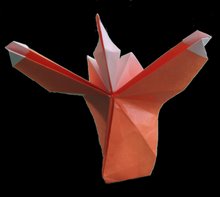
Robert Lang is known by the deep mathematical basis underlying on his models. A couple of years ago he published on his site (an amazing site, I have to say) a beautiful rose of many petals, along with its Crease Pattern; apparently he liked the roses made by Kawasaki and others but his desire was to obtain one with more petals and spread in an opened rose (he certainly accomplished it). Almost immediatly a thread was opened on the British Origami Forum, where many get into the solving of its CP.
http://www.thekhans.me.uk/forum/viewtopic.php?t=1227&postdays=0&postorder=asc&highlight=lang+rose&start=0
To follow its eight pages becomes a fascinating experience, about a group of people helping each others and contributing to achieve a common artistic goal. I was so shocked that I've decided to try it and solve for the first time on my life a crease pattern (though almost all the work was already done ha!).

If the CP is observed, one could think that the choice on the proportions on its horizontal creases is a little complicate, but understanding how Lang's work is done, you realize that behind them is certainly a deep study on the proportions desired by the author to the rose's petals, which reduces their size in the way to the center of the flower. In the same way, vertical folds, separated each one by 1/11, allows it to obtain a pentagonal base, as we will see further. However, to obtain these folds or lines without using a ruler and a calculator was strongly difficult; Daydreamer, on that forum's trhead, used the Reference Finder Software (made by the same Robert Lang) to obtain a folding sequence for the seventh line, and a year after another participant, Silent Winter, showed an incredible method to get all the rest lines from this seventh one.
Even when Daydreamer's sequence is very exact, I wasn't sure about its intuitiveness. So I projected a line to the opposite corner of the end of that line and saw that that angle was almost exactly 20 degrees, and that the distance between the bottom edge to it (29/80, 0.3625) was almost the same that from the right edge to the fourth vertical line (4/11, 0.3636); in a way that could make possible to obtain both folds marking the 45º diagonal from that endline matching the lateral edge to the line. To get a 20º fold is not simple, but in a very interesting site I learned to tri sect any angle and I already knew a way to fold a 60º fold.

The second stage on this exercise was to fold collapse the base, which become more complicated; at the end, the best was make the reverse folds from left to right, column by column, opening a little the accordion resulting structure each time. Very useful was to know that for Lang's CPs only the bold marks are the ones that will be really folded on the final base and that yellow ones means valley and black ones mount :) (I like that, an author that doesn want to keep secrets to the rest). Doing so the base toke form. Note that when collapse, base already takes a concave form in its bottom pentagonal level, resulting probably from the careful selection of its proportions in the design process.







And finally the hardest part, trying to shape and form the petals from its pointy layers that the base gave to us. First twisting the levels, using the inner layers resulted from the reverse folds, distributing the points in different angles, like a sun rays array. I've realized the best was go from bottom level to highest, from the largest petals to the small ones in the center of the flower. Curve the large petals down, lifting their bases a little and finally twisting the small ones in a tube-like around the center. I've done it several times and it is really hard to get a satisfactory result, it's a very fine figure and demands a high level on your folding skills. Is evident that a better result is obtained using fine and thin paper and probably also wet folding with Metyll cellulose.


I've gathered all the info I could, plus some pictures, and made a pdf document, which I offer to everyone that could want it. It was a fascinating an amazing experience to solve this CP and I really appreciate Mister Robert Lang for read it and allow me to share it, even when my resulting flowers are still very ugly. All I can say is that Mister Lang is a MASTER. His diagram for the rose exists on 12th JOAS Convention Book and the las Origami USA Convention Book, which I hope I'll get as soon as possible, to follow the path drawn by him.
Many regards to everybody.
Zip pdf file: rosalang2.pdf.zip



